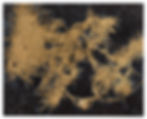IN THE STUDIO WITH GAIL ROTHSCHILD
- Victoria Hood, Founder
- Sep 18
- 4 min read
Taking time and courage to find one's artistic voice
Artist and rock climber Gail Rothschild exudes an energy and determination that even the ancient gods would admire. Slowly but surely, Gail became a regular fixture at Standard Space openings in Sharon, CT (Litchfield County), until one day she confidently declared to my husband and founder Theo Coulombe that she was going to have a show at our gallery. With an open mind and mild expectations, Theo agreed to a studio visit, which ended up being an hour-long adventure of discovery, history, and delight. Gail’s larger-than-life paintings of archaeological textile fragments are the result of collaborations with museum collections like the Museo Egizio in Turin, Italy and The Metropolitan Museum Cloisters in New York City. Each piece mirrors how they tease the artist of stories of its makers, as well as thieves and merchants, collectors, curators and conservators. As Gail states, “I paint as a response to the textile’s illusiveness, honoring its history.” Below is an intimate deep dive on what inspires and drives the unstoppable Rothschild.

Where did you grow up and what is your first impactful memory of art?
I was born in New York City. Some of my earliest memories were visiting the Metropolitan Museum of Art which seemed to me like the greatest treasure trove in the world.
When did you know you wanted to pursue your career in art? What path did you take to become an artist?
At a very young age I began to work alongside my father, Richard Rothschild, who was a marvelous sculptor. He set up a tiny workbench in the basement and gave me a small chisel and mallet. Together, we visited the American Museum of Natural History where we drew the dinosaur fossils. I marveled at their age and their structure. Although my focus as an undergraduate at Yale was in drawing and painting, I kept making things and sculpting. Competitive gymnastics helped hone my appreciation of the physical and haptic in art. After Yale, my peripatetic sculpture career took me around the country where, during museum residencies, I invited the public to consider underappreciated aspects of local history. Even when working in two dimensions and on canvas, my concerns continue to be those of form and structure and time.
How does it feel to have your first solo show at Standard Space?
Because I create works in collaboration with museum collections around the world, my focus and my exhibitions have been in sites from Berlin to Lima, Manhattan to Antwerp. I am so grateful to have the opportunity to share this work with the community I am proud to call home. And boy, was it easier to transport the huge canvases!

What is the inspiration behind these works?
I am not a weaver. My paintings of archaeological textile fragments are the result of collaborations with museum collections. My subjects tease me with stories of their makers, but also of thieves and merchants, collectors, curators and conservators. I paint as a response to the textile’s illusiveness, honoring its history. Re-presented as a monumental abstraction, each mark of paint both makes and unmakes an image of fabric. Over millennia the architectural grid of cloth returns to its biological origins, what looks like a coastline decays and transforms with time. Each painting is testament to the paradox—what is interwoven will ultimately unravel, and that which grows will inevitably decay.
Could you tell us more about your choice to use soft and light colors?
My palette is a direct response to whatever subject I am painting. A five thousand year old fragment of linen from Egypt may be very pale although its structure remains firm. A piece of tapestry from 900 CE Peru may still exhibit strong colors from the dyes that have faded remarkably little in nearly two thousand years.
Which piece is your favorite and why?
My favorite piece is always the one that I am working on. It is the one that I am directly addressing in the studio, carrying on that challenging and ever fascinating dialogue of “what brushstroke do you need next?” and “where are we going on this canvas-bound journey together?”
What do you have next on the horizon?
I currently have several projects in the works. Two of them are represented in the exhibition at Standard Space. Landscape is part of a developing project with the Museo Egizio in Turin, Italy. I am excited to see how ancient Egyptian basketry will connect my sculptural and painterly passions. Another current exploration is with the Metropolitan Museum Cloisters and celebrates the ongoing ten-year-long conservation of the Heroes Tapestries. Lady Lilith and Julius Caesar at the Standard Space represent part of my Heroes Project.

Any last words of advice to aspiring artists?
Making things matters. Making things is hard work. Finding your own language takes a long time. Being willing to change direction takes courage. Go ahead: make things, work hard, and find your own artistic language. Believe that what you are doing is the most important thing you can do. Don’t wait for someone else to tell you it’s good: know it. Have courage. You’ll get there. And “there” may not be where you thought it would be when you began the journey.









